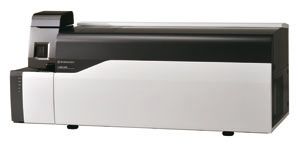Trace level quantitation of multiple compounds
Shimadzu?s new LCMS-8050 triple quadrupole LC-MS/MS meets the growing demand for trace-level quantitation in clinical research and other markets. It incorporates proprietary ultrafast technologies as well as a newly developed ion source and collision cell technology.

Shimadzu’s new LCMS-8050 triple quadrupole LC-MS/MS meets the growing demand for trace-level quantitation in clinical research and other markets. It incorporates proprietary ultrafast technologies as well as a newly developed ion source and collision cell technology. As the flagship model of Shimadzu’s UFMS (Ultra-Fast Mass Spectrometry) product line, the LCMS-8050 features high sensitivity, high data quality and the world’s fastest data acquisition rates.
Delivering attogram-level (10-18 g) sensitivity and possessing unsurpassed ruggedness, the LCMS-8050 achieves its improved sensitivity through two important technologies:
• Newly designed Heated ESI source improves desolvation and enhances ionization efficiency with the addition of a heated gas used in combination with the nebulizer gas
• UFsweeper®III collision cell enhances CID efficiency by optimizing the collision cell pressure.
The world’s fastest data acquisition rates
The newly engineered high voltage power supply enables a maximum scan rate of 30,000 u/sec and a 5 msec polarity switching time, making the LCMS-8050 combined with Nexera UHPLC the ideal platform for laboratory productivity. It is now possible to include 1,000 events with up to 32 channels per event for a maximum of 32,000 MRMs per analysis.
User-friendly Operation and Easy Maintenance
• Plug-in for the new ion source enables easy changing from ESI to APCI or to dual ionization mode (DUIS)
• The LabSolutions LCMS Version 5.60 software provides seamless integration of HPLC and MS control. An automated MRM optimization routine allows unattended optimization of multiple compounds.
For more information please visit www.shimadzu.eu
The Complexity of Oligonucleotide Separations
January 9th 2025Peter Pellegrinelli, Applications Specialist at Advanced Materials Technology (AMT) explains the complexity of oligonucleotide separations due to the unique chemical properties of these molecules. Issues such as varying length, sequence complexity, and hydrophilic-hydrophobic characteristics make efficient separations difficult. Separation scientists are addressing these challenges by modifying mobile phase compositions, using varying ion-pairing reagents, and exploring alternative separation modes like HILIC and ion-exchange chromatography. Due to these complexities, AMT has introduced the HALO® OLIGO column, which offers high-resolution, fast separations through its innovative Fused-Core® technology and high pH stability. Alongside explaining the new column, Peter looks to the future of these separations and what is next to come.
Metabolomics Analysis of Low Birth-Weight Infants Using UHPLC-MS/MS Following Lipid Emulsion
January 10th 2025A recent study aimed to directly compare the changes in serum metabolites among very low birth-rate (VLBW) infants following the administration of the soybean oil-based lipid emulsion and soybean oil, medium-chain triglycerides, olive oil, and fish oil (SMOF) lipid emulsion using untargeted metabolomics techniques.
Analyzing New Drug Modalities: An ISC 2024 Interview with Kelly Zhang
January 10th 2025At ISC 2024 in Liverpool, United Kingdom, LCGC International interviewed Kelly Zhang of Genentech about her work analyzing new drug modalities, such as mRNA, oligonucleotides, peptides, and cell and gene therapies.